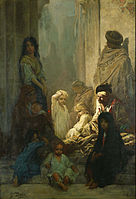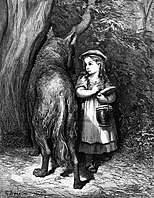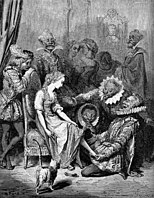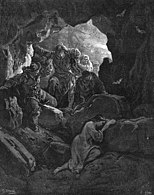Paul Gustave Doré | |
|---|---|
 Photograph by Nadar, 1867 | |
| Born | 6 January 1832 Strasbourg, France |
| Died | 23 January 1883 (aged 51) Paris, France |
| Nationality | French |
| Known for | Painting, etching, illustrations |
Paul Gustave Louis Christophe Doré (/dɔːˈreɪ/; French: [ɡys.tav dɔ.ʁe]; 6 January 1832 – 23 January 1883[1]) was a French artist, printmaker, illustrator, comics artist, caricaturist, and sculptor who worked primarily with wood-engraving.
19세기말에 많은 작품을 남긴 삽화가 중 한 사람이다. 풍부하면서도 괴이한 상상력으로 환상적인 장면들을 많이 그려 낭만파 아카데미 화가들이 널리 모방했다.
1847년 파리로 가서 1848~51년 〈Journal Pour Rire〉에 매주 캐리커처 석판화들을 기고했으며, 석판화집(1847~54)도 여러 권 출판했다. 나중에는 목판으로 제작한 삽화들로 명성을 얻었다. 목판조각가들을 40명 이상 고용해 삽화가 들어 있는 책을 90권 이상 출판했다.
작품 중 빼어난 것으로는 〈라블레 전집 Oeuvres de Rabelais〉(1854), 발자크의 〈기이한 이야기들 Les Contes drolatiques〉(1855), 〈2절판 성경〉(1866), 단테의 〈지옥편 Inferno〉(1861) 등이 있다. 종교적 인물이나 역사적 인물들의 큰 초상 조각가로도 어느 정도 성공을 거두었지만 이러한 작품에서는 삽화의 자연스런 활기를 찾아보기 어렵다.[다음 백과]
Biography
Doré was born in Strasbourg on 6 January 1832. By age 5 he was a prodigy artist, creating drawings that were mature beyond his years. Seven years later, he began carving in stone.[citation needed] At the age of 15, Doré began his career working as a caricaturist for the French paper Le journal pour rire.[2] Wood-engraving was his primary method at this time.[3] In the late 1840s and early 1850s, he made several text comics, like Les Travaux d'Hercule (1847), Trois artistes incompris et mécontents (1851), Les Dés-agréments d'un voyage d'agrément (1851) and L'Histoire de la Sainte Russie (1854). Doré subsequently went on to win commissions to depict scenes from books by Cervantes, Rabelais, Balzac, Milton, and Dante. He also illustrated "Gargantua et Pantagruel" in 1854.[citation needed]
In 1853 Doré was asked to illustrate the works of Lord Byron.[4] This commission was followed by additional work for British publishers, including a new illustrated Bible. In 1856 he produced 12 folio-size illustrations of The Legend of The Wandering Jew, which propagated longstanding antisemitic views of the time,[5] for a short poem which Pierre-Jean de Béranger had derived from a novel of Eugène Sue of 1845.[6][7][8]
In the 1860s he illustrated a French edition of Cervantes's Don Quixote, and his depictions of the knight and his squire, Sancho Panza, have become so famous that they have influenced subsequent readers, artists, and stage and film directors' ideas of the physical "look" of the two characters.[9] Doré also illustrated an oversized edition of Edgar Allan Poe's "The Raven", an endeavor that earned him 30,000 francs from publisher Harper & Brothers in 1883.[10]
Doré's illustrations for the Bible (1866) were a great success, and in 1867 Doré had a major exhibition of his work in London. This exhibition led to the foundation of the Doré Gallery in Bond Street, London.[11] In 1869, Blanchard Jerrold, the son of Douglas William Jerrold, suggested that they work together to produce a comprehensive portrait of London. Jerrold had obtained the idea from The Microcosm of London produced by Rudolph Ackermann, William Pyne, and Thomas Rowlandson (published in three volumes from 1808 to 1810).[12] Doré signed a five-year contract with the publishers Grant & Co that involved his staying in London for three months a year, and he received the vast sum of £10,000 a year for the project. Doré was mainly celebrated for his paintings in his day. His paintings remain world-renowned, but his woodcuts and engravings, like those he did for Jerrold, are where he excelled as an artist with an individual vision.[citation needed]
The completed book London: A Pilgrimage, with 180 wood-engravings, was published in 1872. It enjoyed commercial and popular success, but the work was disliked by many contemporary critics. Some of these critics were concerned by the fact that Doré appeared to focus on the poverty that existed in parts of London. Doré was accused by The Art Journal of "inventing rather than copying".[13] The Westminster Review claimed that "Doré gives us sketches in which the commonest, the vulgarest external features are set down".[14] The book was a financial success, however, and Doré received commissions from other British publishers.[citation needed]
Doré's later work included illustrations for new editions of Coleridge's Rime of the Ancient Mariner, Milton's Paradise Lost, Tennyson's Idylls of the King, The Works of Thomas Hood, and The Divine Comedy. Doré's work also appeared in the weekly newspaper The Illustrated London News.[citation needed]
Doré never married and, following the death of his father in 1849, he continued to live with his mother[citation needed], illustrating books until his death in Paris following a short illness. The city's Père Lachaise Cemetery contains his grave.[15] At the time of his death in 1883, he was working on illustrations for an edition of Shakespeare's plays.[16] The government of France made him a Chevalier de la Légion d'honneur in 1861.
Gallery
- Gustave Doré
La Sainte Trinite, Glynn Vivian Art Gallery
Ecce Homo, Glynn Vivian Art Gallery
La folie, Glynn Vivian Art Gallery
Landscape in Scotland, ca. 1875, Toledo Museum of Art
Le Christ quittant le prétoire 1867–72, Strasbourg Museum of Modern and Contemporary Art
Andromeda, 1869, Chimei Museum, Tainan, Taiwan
Dante's The Divine Comedy
Landscape in Scotland, ca. 1878, Walters Art Museum
Doré illustrated several fairy tales: Cendrillon (or Cinderella).
A Doré wood engraving illustration from The Divine Comedy
A Backstreet in London, 1868, National Gallery of Art
Edyrn with His Lady and Dwarf Journey to Arthur's Court, in Idylls of the King by Lord Alfred Tennyson, illustrated by Gustave Doré
'♣ 미술(美術) 마당 ♣ > - 화가[畵家]' 카테고리의 다른 글
| [독일 -19세기]Adrian Ludwig Richter (0) | 2019.09.13 |
|---|---|
| [프랑스 여류화가] 베르트 모리조[Berthe Morisot] (0) | 2019.09.10 |
| [네델란드]Willem Roelofs (0) | 2019.08.18 |
| [이탈리아]벨루토[Bernardo Bellotto] (0) | 2019.07.30 |
| [영국]Thomas Miles Richardson (0) | 2019.07.29 |
































